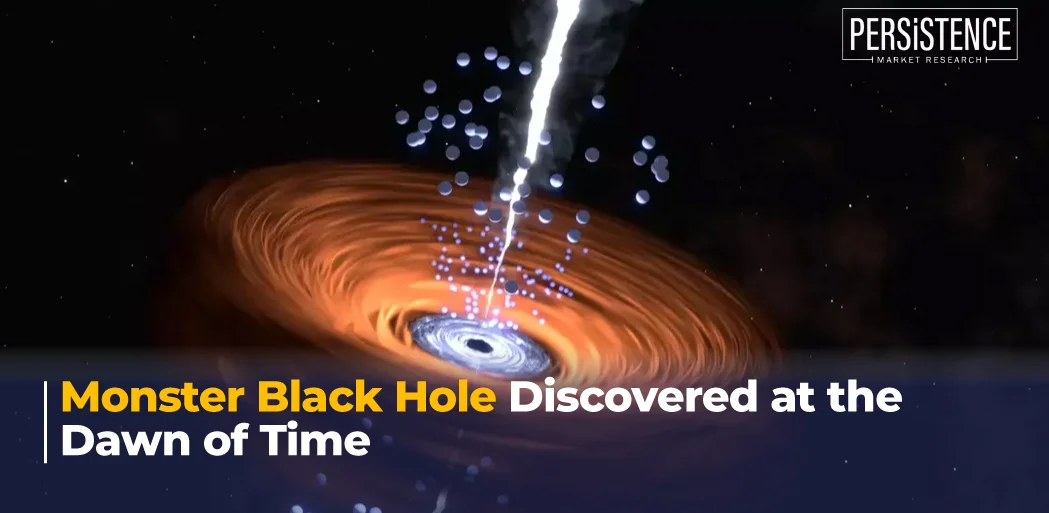- Blog
- Monster Black Hole Found Just 500m Years After Big Bang
Monster Black Hole Discovered at the Dawn of Time
Published On : 21 Aug 2025
In what can only be deemed a discovery of epic proportions, an international team of astronomers rewound the cosmic clock to just 500 million years after the Big Bang, when the universe was only 3 percent of its current age, and have now confirmed that at this early moment a colossal supermassive black hole had already taken shape. Concealed inside a compact galaxy known as CAPERS-LRD-z9, this “Little Red Dot” is home to a black hole weighing as much as 300 million Suns, conferring on it the epithet of being the earliest confirmed black hole ever detected. Led by the University of Texas at Austin’s Cosmic Frontier Center, the discovery was powered by the James Webb Space Telescope (JWST) and not only does it break several records but it has completely recalibrated how scientists think about the formation of black holes, evolution of galaxies, and the cosmic dawn.

A Tiny Glimpse into the Mighty Cosmic Past
CAPERS-LRD-z9 lies 13.3 billion light-years away, yet its light only now reaches us, offering a snapshot of a universe still assembling its first galaxies. Astronomers used JWST’s CAPERS survey (CANDELS-Area Prism Epoch of Reionization Survey) to split the light of the galaxy into its spectral components. This process allowed them to find the tell-tale signs of swirling gas moving at extreme speeds. As the gas receded away from us, it emanated red-shifted light, and when it raced towards us, it blue-shifted. This behavior of the wavelengths of lights can be seen as a Doppler fingerprint that more than confirmed the presence of a black hole, a diagnostic far stronger and superior than imaging alone. In fact, about half of the galaxy’s total mass may already reside in the black hole itself, a ratio significantly higher than seen in any other of the newer, modern galaxies such as the Milky Way.
Not One, But Many
The team of astronomers has also identified dozens of compact, crimson galaxies in the young universe. Now christened Little Red Dots, their radiance was once attributed to bursts associated with rapid star formation. But CAPERS-LRD-z9 has dispelled this assumption by confirming that their unusual brightness and color more likely originates from actively feeding black holes, where the immense gravity funnels gas inward and heats it to incandescence. Dense gas clouds surrounding these black holes absorb and redden the emitted light, producing the distinct “red dot” appearance. CAPERS-LRD-z9, with its supermassive black hole and striking luminosity, now provides unequivocal evidence that Little Red Dots may in fact be early black hole-dominated galaxies.
An Untimely Birth of a Monster
The scale of this finding is beyond astonishing. An absurd but fitting analogy would be stumbling onto a fully grown elephant in a room meant for newborn infants. Traditional theories held that black holes began as light seeds, which are simply stellar remnants weighing not more than a few hundred Suns, and then grew slowly through gas accretion and mergers over billions of years.
But CAPERS-LRD-z9 repudiates this gradualist school of thought. As the JSWT data suggest, at less than half a billion years old, the galaxy’s black hole already outweighs hundreds of millions of Suns. How could it have formed so quickly? Two leading, most sensible possibilities need to be explored:
- Direct collapse: Massive primordial gas clouds may have skipped the star formation stage altogether, collapsing straight into black holes equivalent to tens of thousands of Suns in mass.
- Hyper-Eddington growth: Turbulent conditions in the young universe might have allowed black holes to feed on and swallow matter at a much faster rate than what standard physics can predict.
In either case, a revisiting of black hole growth models is warranted and perhaps even rewriting parts of the cosmic evolution theory.
The Reionization Epoch
The discovery also ties into one of astronomy’s grand narratives of reionization, which refers to a period when the first stars and galaxies lit the cosmos up, ionizing hydrogen and converting the dark, opaque universe into the transparent one we see today. In all likelihood, black holes such as the one in CAPERS-LRD-z9 played an instrumental role during this period. By emitting high-energy radiation and powerful winds, they could have accelerated reionization, shaped star formation, and sculpted the structure of the early galaxies. Instead of standing on the sidelines as mere byproducts of galaxy growth, these primordial black holes may have been the key architects of the first luminous bodies to ever form in the universe.
The Continuity of Exploration
The implications of this discovery are vast and far-reaching. If standard simulations cannot produce such massive black holes so early, something in our models is either missing or incomplete or both. What could potentially explain these gaps? One explanation could be that magnetic fields are channeling gas into black holes way more efficiently than expected. Another possibility could be that primordial black holes were born from fluctuations produced during the inflationary epoch. The breakdown of the laws of physics near event horizons where accretion dynamics get altered may also help us understand the formation of early massive black holes. Future observations may unify spectroscopy with gravitational wave astronomy, unveiling the history of mergers of these cosmic titans. Missions such as the Nancy Grace Roman Space Telescope and Extremely Large Telescopes (ELTs) will push this frontier beyond its current scope, probing even earlier epochs.
Moving Forward with JWST
Accomplishing its task of revolutionizing astronomy, the upcoming campaigns of the JSWT will measure the spin, accretion rates, and chemical environment of the supermassive black hole residing within CAPERS-LRD-z9. These data may also reveal whether it is truly a heavy-seed black hole or a cosmic glutton that grew at breakneck speed. The answers will continue to shake our foundational cosmological knowledge, perhaps even informing how our own Milky Way’s central black hole may have spawned, and by extension, how the visible universe we inhabit came to be structured.
Many Miles to Go
The confirmation of the universe’s earliest monster black hole is simply the starting point of a saga of cosmic proportions. From the enigmatic glow of the Little Red Dots to the outsized role of early black holes, discoveries such as CAPERS-LRD-z9 are a reminder of the endless ability of the universe to surprise us and hold us in awe of its complexity and elegance. As we refine our telescopes and stretch the boundaries of our explorative capacity, we may find ourselves embarking on a journey that completely overhauls our understanding of the universe and help us better comprehend our place in it.
Industry Report

Request Report Sample
Your privacy is important to us; your data is secure
Contact Us
Latest Reports
-
Piezoresistive Pressure Sensor Market by Sensor Type (Absolute, Gauge, Differential, Sealed), Pressure Range (Low Pressure (<10 kPa), Medium Pressure (10 kPa – 1000 kPa), High Pressure (>1000 kPa)), End-Use Industry (Automotive & Transportation, Industrial Manufacturing, Healthcare, Aerospace & Defense, Electronics) and Regional Analysis for 2026-2033
-
Aquarium Accessories Market by Product Type (Filtration Items, Lights & Hoods, Temperature Control Systems, Others), End-User (Residential, Commercial), Distribution Channel (Online, Offline), and Regional Analysis for 2026-2033
-
Oxygen Therapy Market by Product Type (Compressed Oxygen, Concentrated Oxygen, Liquid Oxygen), Disease (Respiratory Disorder, Cardiovascular Disease, Sleep Apnea, Pneumonia), End-User (Hospitals, Home Healthcare, Clinics), and Regional Analysis for 2026-2033
-
Air Curtains Market by Product Type (Non‑Recirculating, Recirculating, Heated, Others), Airflow Capacity (Up to 500 m³/h, 500–1000 m³/h, 1000–1500 m³/h, Above 1500 m³/h), Application (Commercial, Industrial, Residential, Others), and Regional Analysis for 2026–2033
-
Personalized Stationery Market by Product type (Storage & Filling Products, Paper-Based Products, Drawing & Writing Instruments, Accessories, Bags, Others), Application (Educational Institutes, Corporate Offices, Personal Use, Hospitals, Others), and Regional Analysis for 2026–2033
